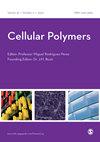Applications of Core Retraction in Manufacturing Low-Density Polypropylene Foams with Microcellular Injection Molding
IF 1.9
4区 医学
Q4 MATERIALS SCIENCE, BIOMATERIALS
引用次数: 1
Abstract
Without modifying existing part and mold designs, the conventional microcellular injection molding (MIM) process can typically save about 5–10% material without encountering problems such as incomplete filling, excessive shrinkage, or deteriorating microstructure and mechanical properties. In this study core retraction was used in combination with the MIM process to produce thick polypropylene (PP) parts (up to 7.6 mm thick) with high density reductions of 30% and 55%. The cavity volume was modified by changing the retraction distance, which enabled control of density reductions. The lowest densities were achieved with this core retraction-aided microcellular injection molding (CR-MIM) process, the results of which could not have been achieved by the conventional MIM process alone. The effects of delay time in core retraction and weight reduction on the microstructure of the core and skin layers were investigated. It was shown that the CR-MIM process yielded better microstructure and tensile properties than the conventional MIM process. Use of core retraction also yielded more consistent densities and tensile properties throughout the length of the foamed parts.缩芯技术在微孔注射成型制造低密度聚丙烯泡沫塑料中的应用
在不修改现有零件和模具设计的情况下,传统的微孔注射成型(MIM)工艺通常可以节省约5-10%的材料,而不会遇到填充不完全、过度收缩或微观结构和机械性能恶化等问题。在这项研究中,芯收缩与MIM工艺相结合,生产厚聚丙烯(PP)零件(厚达7.6 mm),高密度降低30%和55%。通过改变回缩距离来改变腔体体积,从而可以控制密度的降低。最低的密度是通过这种芯收缩辅助微细胞注射成型(CR-MIM)工艺实现的,其结果无法通过传统的MIM工艺单独实现。研究了缩芯延迟时间和减重对芯层和蒙皮层微观结构的影响。结果表明,CR-MIM工艺比传统的MIM工艺具有更好的组织和拉伸性能。使用芯收缩也产生了更一致的密度和拉伸性能在整个泡沫部件的长度。
本文章由计算机程序翻译,如有差异,请以英文原文为准。
求助全文
约1分钟内获得全文
求助全文
来源期刊

Cellular Polymers
工程技术-材料科学:生物材料
CiteScore
3.10
自引率
0.00%
发文量
9
审稿时长
3 months
期刊介绍:
Cellular Polymers is concerned primarily with the science of foamed materials, the technology and state of the art for processing and fabricating, the engineering techniques and principles of the machines used to produce them economically, and their applications in varied and wide ranging uses where they are making an increasingly valuable contribution.
Potential problems for the industry are also covered, including fire performance of materials, CFC-replacement technology, recycling and environmental legislation. Reviews of technical and commercial advances in the manufacturing and application technologies are also included.
Cellular Polymers covers these and other related topics and also pays particular attention to the ways in which the science and technology of cellular polymers is being developed throughout the world.
 求助内容:
求助内容: 应助结果提醒方式:
应助结果提醒方式:


